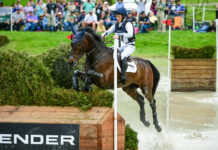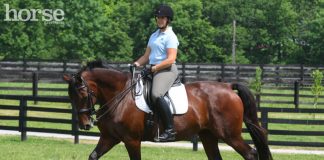
In Part I of Dressage Mysteries Solved, dressage clinician, author and three-time Olympic coach Jane Savoie outlined the connecting aids required for putting your horse on the bit:
- Close your legs on the horse to generate power from behind.
- Close your outside hand in a fist to capture, contain and recycle that power.
- Squeeze and release (vibrate) the inside rein, like squeezing water out of a sponge, to counter your closed outside hand.
In order to get the desired effect from these connecting aids, it’s important that your horse responds obediently to your leg, seat and hand aids. This is often overlooked, as many of us have a very lazy or hot horse that seems to ignore our aids. Savoie offers her tried-and-true training methods for correcting this problem.
The Lazy Horse
Savoie stresses that your connecting aids won’t work if your horse isn’t in front of your driving aids, which are the first set of aids you need to establish. For example, when you put your legs on, your horse should immediately move forward. “Remember that horses are extremely sensitive to touch, and no matter how lazy a horse is, he can feel a fly land on his side and flick it off,” says Savoie.
“It’s usually the rider who makes the horse dull,” explains Savoie. “The horse isn’t electric enough, so the rider uses more leg. That works for a while, but then the horse gets dull to that, so the rider starts putting on spurs. Then the horse gets used to that so the spurs get bigger.” This cycle is common, and as time goes by, the leg aid gets louder and louder.
“The reason your horse isn’t reacting is because you’ve started screaming with your aids,” continues Savoie. “The first thing you have to do is decide that you’re not going to close your legs any stronger than a fly landing on your horse’s side,” she says. This is the concept of “whisper and shout”: When you whisper an aid, your horse should shout his answer—instead of the other way around.
The Correction
Instead of constantly repeating your aid or making it stronger, you need to make a correction. “The correction depends on the sensitivity of your horse,” Savoie explains. “You can either bump-bump-bump with your legs, or you can use your long whip and tap-tap-tap behind your leg to chase your horse forward. Either way, you need to get a really forward response to the correction. If you’re walking, you want to bump or tap until your horse is trotting; if you’re trotting, you want to do it until he breaks into the canter.”
The most important part of the correction is to re-test with a light, whispering aid. “For example, in a transition from walk to trot, lightly close your legs, and your horse should surge into the trot,” says Savoie. “If he doesn’t, tap-tap-tap, but then you must go back to the walk and re-test with a very light aid for that transition. Consistently testing your horse for response to light aids will keep him electric to your leg.”
The Hot Horse
The same theory of testing and re-testing also applies to a hot horse that would rather run through your hand than slow down. “One of the jobs of your outside rein is to control speed,” says Savoie. “If you give a little tweak or squeeze-release on the outside rein to tell your horse to slow down and he just ignores you and keeps running forward, then do a downward transition.
“If you’re in the trot, come to the walk; if you’re in the walk, come to the halt,” continues Savoie. “But then go forward again and re-test the aid with a little squeeze-release on the outside rein; if he still ignores you, do another downward transition, then go forward and re-test the outside rein aid again.
“If you get a response that is better or pretty good, then you have to make the correction again and re-test the aid,” says Savoie. “When you get a 100-percent, whole-hearted response, either from the leg or the outside rein, then praise your horse generously.”
Testing the Connection
Once your horse is reacting to a feather-light touch and you’ve combined the three sets of connecting aids, you will want to know if your horse is truly on the bit or just “faking” by posing, instead of using his body correctly.
- Giving with the Inside Rein: “The heart of your connecting aids is the driving aid through your closed outside hand, which gives you the longitudinal bend over the horse’s back,” says Savoie. “If your horse is honestly connected through the outside rein, you can put a loop in the inside rein for a couple of strides and nothing should change; your horse shouldn’t bend his neck to the outside, change speed or lose balance.
“If he isn’t connected into that outside rein when you put a loop in the inside rein, he will either counter-flex at the poll or counter-bend at the neck,” explains Savoie.
- Stretchy Circle: “Open your fingers and allow your horse to chew the reins out of your hands,” says Savoie. “If he is truly on the bit, he will take the reins forward, down and out as a natural extension of the longitudinal bend over his back.”

Using these tests regularly during your rides will tell you if your connecting aids are (or aren’t) getting through to your horse.
Common Rider Mistakes
Of course, no rider is perfect, so it’s good to be aware of the most common errors you might make that can hinder your horse’s connection.
- Hands too close to the saddle: “Your hands should be just above the withers, which I call the ‘work area,'” says Savoie. “If you bring your hands closer to the saddle, you’re actually stealing power from your horse’s hind legs rather than receiving and recycling power.”
- Riding from front to back: “You should never use your hands without first driving your horse’s hind legs forward, since there’s nothing to recycle if you haven’t created that power,” says Savoie. “As a way of making sure that you’re riding your horse from back to front, close your legs and feel him surge into a lengthening for one full stride before you close your outside hand and vibrate the inside rein, rather than giving these aids almost simultaneously (which you will do eventually).”
- Too much inside rein: “A lot of times, people focus on giving and taking with the inside rein, since moving the bit in the horse’s mouth causes him to chew and flex at the jaw, and then his face approaches the vertical,” says Savoie. “The horse is going to feel good in your hand for the moment, but since you haven’t created the connection over his back first, any time you go to do something different–such as a transition or a change of direction–your horse is going to come off the bit, since he was never truly on the bit to begin with. What you do with your inside hand is minor compared to what you do with your driving aids and your outside hand.”
Troubleshooting Other Mistakes
If you’ve tried to correct all of the common rider mistakes and your horse is still not honestly on the bit when you use the two tests, you may need to vary each of the three connecting aids until the connection improves.
- Leg: “First, just use your driving aids to see if you get a ‘hot off the leg’ reaction into a lengthening,” suggests Savoie. “If you don’t, either bump-bump-bump with your legs or tap-tap-tap with the whip, then go back and re-test the driving aids to make sure you’ve got an electric response.”
- Outside Rein: “Because riders tend to emphasize the inside rein as opposed to the outside rein, they think that they’re containing and recycling the power from the hind legs with the outside rein, when in fact they might be too soft,” says Savoie. “Give your connecting aids again, but try making your outside hand heavier.”
- Inside Rein: “The vibrations on the inside rein counter the action of the closed outside hand, but that may not be enough if when your horse’s stiff side is on the inside,” says Savoie. “In that case, you might increase the influence of the inside rein by using your legs and outside rein the same way, but instead of vibrating the inside rein, give an indirect rein aid by turning your wrist upward three times (like turning a key in a lock) so you get flexion of your horse’s poll to the inside.”
- “Dropping” the Horse: If your horse seems to be on the bit after you give the connecting aids, but he loses connection after a few strides, you may have dropped your supporting outside rein. “Connection is like an isometric exercise–the horse’s hind legs are pushing into the outside rein,” says Savoie. “In that case, give the normal connecting aids, but when you soften after three seconds, only soften your outside hand 50 percent of what you did before and see if your horse stays connected more consistently for more strides.”
Frequency of Connecting Aids
Once you’ve gotten the hang of effective connecting aids, how do you keep your horse on the bit throughout your ride? “Apply the connecting aids for three seconds, then soften and wait a few strides before giving them again–then soften,” says Savoie. “It’s almost a constant process of giving these connecting aids, but because they’re so light–just a hair more than maintenance pressure– they’re almost just a thought in your mind once your horse is trained to respond to them: you ever-so-slightly close your legs and then your outside hand just to confirm the connection.
“Any time you a transition–whether from gait to gait, or from left bend to right bend–it’s a given that your horse will lose balance and connection,” continues Savoie. “So if you’re a thinking rider, you will precede any kind of transition with the connecting aids, and then superimpose the connecting aids over the transition.
“For example, if you’re in the walk and you want to trot, you’d start your connecting aids while you’re still walking,” explains Savoie. “Then you would increase your legs a little bit to tell your horse to trot, but while you’re doing that transition, your outer hand stays closed and your inner hand vibrates the inside rein so you’re using the connecting aids before, during and after the transition. The movements come easily if your horse is connected.”
Take Frequent Breaks
Introducing your horse to riding on the bit requires muscles that he hasn’t fully developed yet, so be sure to take frequent breaks. “Ask your horse to go on the bit for a couple of minutes, then walk on a loose rein to let his muscles relax. Whether your ride ends up being 20 minutes or 45 minutes, there should be many breaks to walk on a loose rein within that time.”
Exercise: Accelerating Onto a Small Circle
If you have never ridden a horse that is correctly on the bit, it may be hard to grasp the feeling you’re striving to create. Or you may be riding a horse that just isn’t “getting it,” even if you use the correct aids. “By accelerating onto a small circle, you’re increasing those three sets of aids,” says Savoie. “You have more driving aid because you’re accelerating onto the circle; you have more bending aid because it’s a small circle; and you have more outside rein because it determines the size of the circle.
“It might last more than three seconds for you to walk onto a 6-meter circle or trot onto a 10-meter circle, but your cue to soften is when you blend back onto a 20-meter circle,” continues Savoie. “You’re basically simulating and magnifying your connecting aids with this exercise for a horse who isn’t getting it or a rider that needs to know what they’re looking for.”
By systematically working through these exercises and being aware of the most common horse and rider mistakes, you can teach your horse to be responsive and connected throughout your rides.
Read more dressage training advice from Jane Savoie:
Dressage Mysteries Solved Part I
Get Your Horse on the Bit
Meet the Trainer: Jane Savoie was the reserve rider for the 1992 U.S. Olympic dressage team in Barcelona, Spain, and has coached at three Olympic Games. She now travels throughout the country giving workshops and seminars. Her latest work includes the CD/DVD sets “Freedom from Fear,” “Program Your Position” and “A Happy Horse Home Study Course.” www.janesavoie.com
This article originally appeared in the February 2010 issue of Horse Illustrated magazine. Click here to subscribe!






